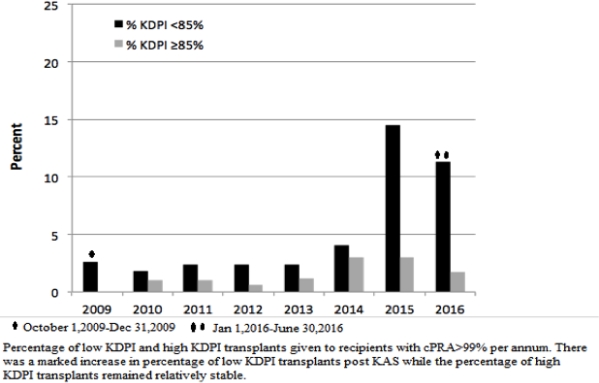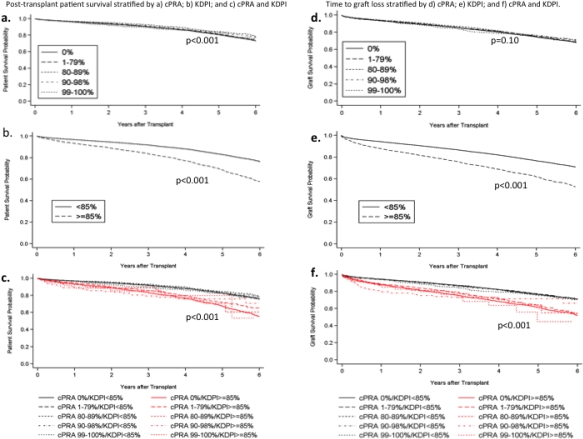Impact of KDPI and CPRA on Outcomes in Kidney Transplant Recipients
Cedars Sinai Medical Center, Los Angeles.
Meeting: 2018 American Transplant Congress
Abstract number: 426
Keywords: Kidney transplantation, Panel reactive antibodies, Sensitization
Session Information
Session Name: Concurrent Session: Kidney Deceased Donor Allocation - 2
Session Type: Concurrent Session
Date: Tuesday, June 5, 2018
Session Time: 2:30pm-4:00pm
 Presentation Time: 2:54pm-3:06pm
Presentation Time: 2:54pm-3:06pm
Location: Room 6E
Introduction: The new KAS has led to a marked increase in kidney transplants among highly sensitized recipients, mostly attributable to higher allocation of low KDPI donors. We investigated whether low KDPI donors impact patient and graft outcomes differently in sensitized and non-sensitized recipients.
Methods: Using data from OPTN/UNOS, we investigated the association of calculated panel reactive antibody (CPRA) and KDPI on patient and graft survival in 69,088 adult deceased donor recipients transplanted from 10/2009-6/2016. Patients were categorized by CPRA at transplant: 0%, 1-79%, 80-89%, 90-98%, and 99-100%. Time-to-event analyses were performed for recipients according to CPRA, KDPI (low <85% vs. high ≥85%), and the combination of CPRA and KDPI.
Results: There was a five fold increase in the percentage of low KDPI transplants allocated to cPRA≥99% recipients following KAS implementation, but no difference in high KDPI transplants.  CPRA was associated with a small but statistically significant difference in unadjusted patient survival, but no difference in graft survival . When stratified by KDPI, patient survival and graft survival was lower for recipients of a high KDPI donor. When stratified by KDPI and CPRA, patient and graft survival were largely determined by KDPI, whereas CPRA had relatively little impact.
CPRA was associated with a small but statistically significant difference in unadjusted patient survival, but no difference in graft survival . When stratified by KDPI, patient survival and graft survival was lower for recipients of a high KDPI donor. When stratified by KDPI and CPRA, patient and graft survival were largely determined by KDPI, whereas CPRA had relatively little impact. After adjustment for CPRA and other confounders, high KDPI was associated with a 47% increased risk of death (HR 1.47; CI 1.38-1.57) and 67% increased risk of graft loss compared to low KDPI (HR: 1.67; CI 1.58-1.76).
After adjustment for CPRA and other confounders, high KDPI was associated with a 47% increased risk of death (HR 1.47; CI 1.38-1.57) and 67% increased risk of graft loss compared to low KDPI (HR: 1.67; CI 1.58-1.76).
Conclusions: KDPI is a stronger determinant of patient and graft outcomes than CPRA. Higher priority given to sensitized candidates in the post-KAS era draws low KDPI donors from less sensitized candidates. The effect of this phenomenon on outcomes of less sensitized patients needs to be evaluated.
CITATION INFORMATION: Sethi S., Najjar R., Peng A., Vo A., Jordan S., Huang E. Impact of KDPI and CPRA on Outcomes in Kidney Transplant Recipients Am J Transplant. 2017;17 (suppl 3).
To cite this abstract in AMA style:
Sethi S, Najjar R, Peng A, Vo A, Jordan S, Huang E. Impact of KDPI and CPRA on Outcomes in Kidney Transplant Recipients [abstract]. https://atcmeetingabstracts.com/abstract/impact-of-kdpi-and-cpra-on-outcomes-in-kidney-transplant-recipients/. Accessed January 7, 2026.« Back to 2018 American Transplant Congress
